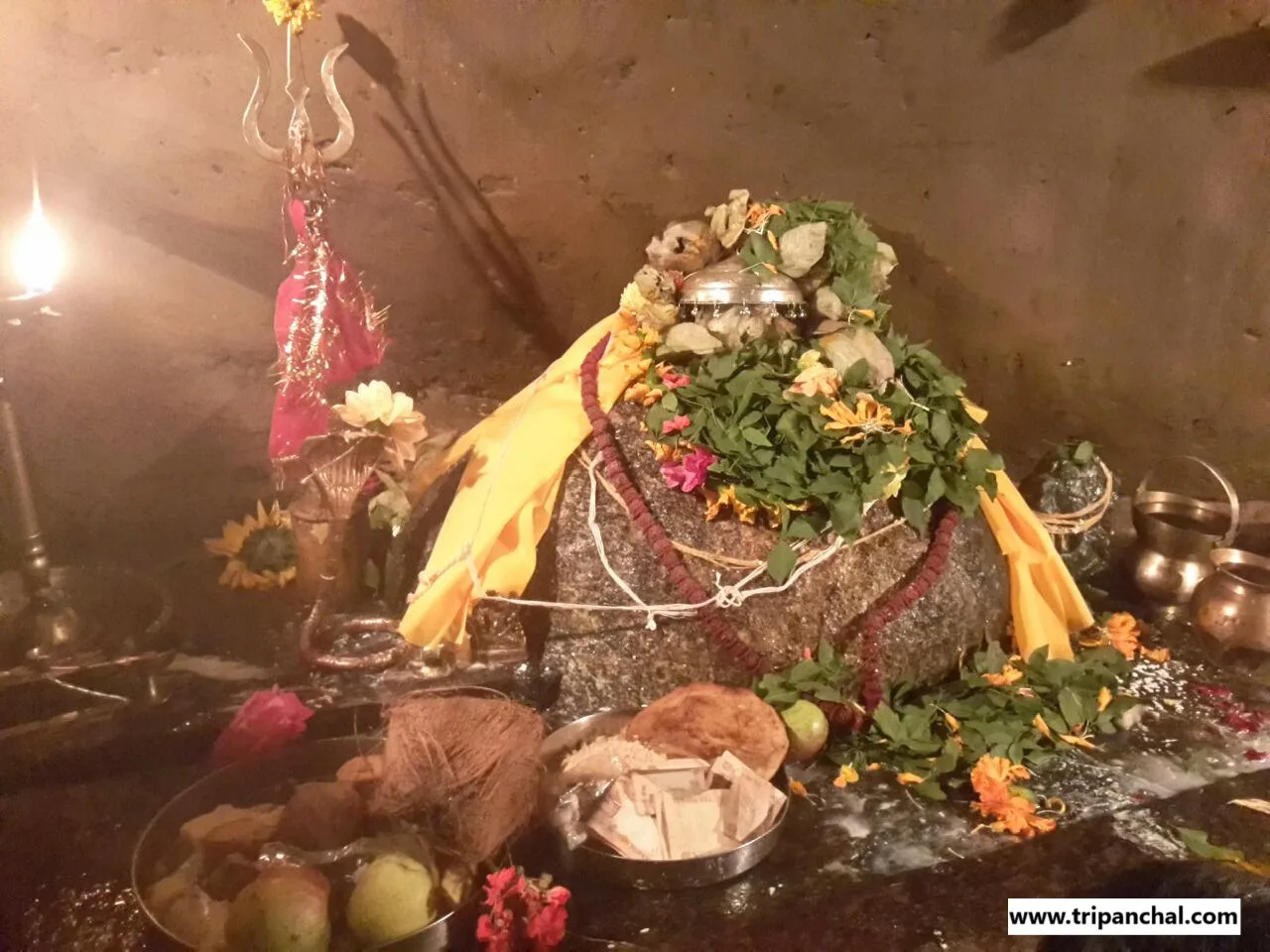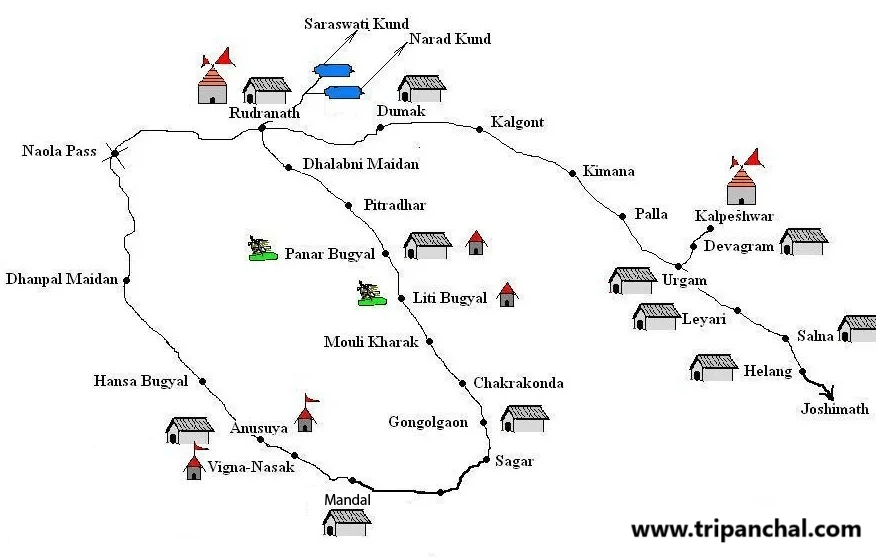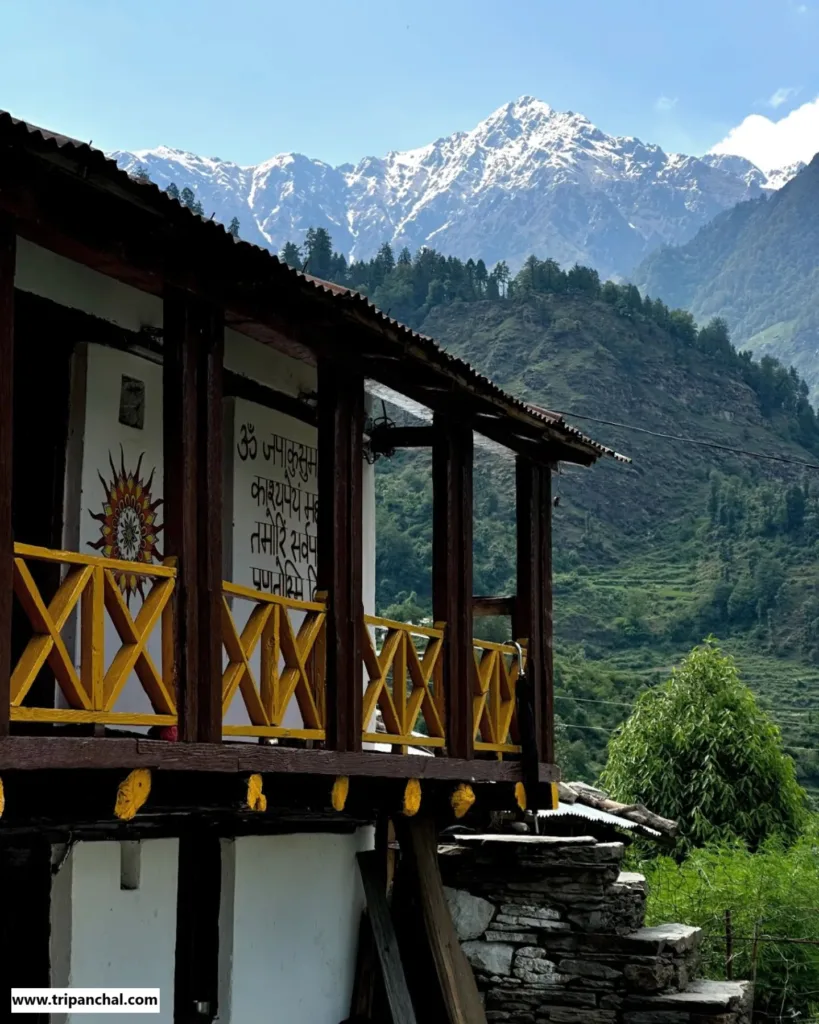- Key Points: Kalpeshwar Temple, Devgram Village, Urgam Valley, Panch Kedar.
- State: Uttarakhand, India.
- Duration: 4 Nights 3 Days.
- Altitude: 2,200 meters (7,217 feet) above sea level.
- Trek Distance: Approximately 300-500 meters only.
- Summer temperature: (15°C to 25°C)
- Winter temperature: (0°C to 10°C)
- Best Time To Visit: All time accessible.
- Aarti Time: Morning Prayer starts at 6:00 AM and Evening Prayer starts at 6:30 PM daily.
- Trek Level: Easy.
- How to Reach: Take the bus from New Delhi to Rishikesh ISBT. Then, take a local bus or taxi from Rishikesh ISBT to Joshimath. After that, board a local bus to Helang. From Helang, you will need to take one more sharing taxi to reach Devgram village. Finally, from Devgram you can begin your trek.
- Budget: ₹6,000-₹6,500 Per Person.
- Weather: In winters or In the summers you can experience a Pleasant Weather.
Introduction to the Kalpeshwar Temple
Nestled amidst the breathtaking Himalayan landscape of Uttarakhand, India, Kalpeshwar Temple stands as a sacred haven of tranquility and spirituality. This ancient temple, dedicated to Lord Shiva, provides not just a deep spiritual experience but also an opportunity to fully enjoy the natural beauty of the area.
The serene surroundings and stunning landscapes make it an ideal destination for those seeking spirituality as well as nature lovers. In this article, we will take you on a journey to discover the rich history, mythology, and natural wonders surrounding the Kalpeshwar Temple.

Table of Contents
1. The Historical Significance of Kalpeshwar Temple
1.1 Geographical Location and Accessibility
1.2 Architecture and Design of the Temple
2. The Mythological Connections
2.1 The Legend of Lord Shiva and Kalpeshwar
3. Rituals and Worship at Kalpeshwar Temple
4. Embarking on the Trek
4.1 Rishikesh to Joshimath
4.2 Joshimath to Kalpeshwar Temple via Helang & Devgram
4.3 Kalpeshwar Temple to Joshimath
4.4 Joshimath to Rishikesh
5. Exploring the Surrounding Natural Beauty
5.1 The Himalayan Scenic Splendor
5.2 Nearby Attractions and Treks
6. Experiencing Spirituality at Kalpeshwar
6.1 Spiritual Significance and Importance
6.2 Pilgrimage and Devotees
7. Practical Information for Visitors
7.1 How to Reach Kalpeshwar Temple
7.2 Accommodation and Essentials
1. The Significance of Kalpeshwar Temple
1.1 Geographical Location and Accessibility
Located in the picturesque Urgam Valley, a region adorned with dense forests, lush greenery, and clear streams. The temple is surrounded by towering snow-capped peaks, making it a visual delight for nature enthusiasts. The pristine surroundings create an atmosphere of serenity and spirituality, drawing visitors from far and wide.
To reach Kalpeshwar Temple, one must undertake a journey of approximately 12 kilometers from Helang, a small village on the Joshimath-Badrinath route. Helang serves as the base camp for the temple and can be reaches via road from the town of Joshimath. From Helang, it’s a scenic trek through dense forests and terraced fields, taking you closer to the divine abode.
Earlier, Kalpeshwar temple was accessible only by trekking, spanning a distance of about 12 kilometers. However, a road has been built up to devgram, allowing you to reach devgram by taxi. The trekking distance from Devgram to Kalpeshwar temple is now only around 300-500 meters.

1.2 Architecture and Design of the Temple
Kalpeshwar Temple is a small, stone structure with a simple yet charming architectural design. The temple’s shikhara (spire) stands tall against the backdrop of the towering mountains. The sanctum sanctorum houses the divine lingam (an abstract representation of Lord Shiva), which is believed to be one of the oldest in the region.
The inner sanctum is a adorned with images of various deities, and the walls feature ancient inscriptions that add to the temple’s historical significance. A Nandi (the sacred bull, a vehicle of Lord Shiva) statue guards the entrance, welcoming devotees with its majestic presence.
2. The Mythological Connections
2.1 The Legend of Lord Shiva and Kalpeshwar
The origins of Kalpeshwar Temple are steeped in Hindu mythology. According to legend, when the Pandavas of the Mahabharata epic sought Lord Shiva to absolve them of the sins committed during the Kurukshetra war, Lord Shiva evaded them by taking the form of a bull. The parts of Lord Shiva’s body, known as the Panch Kedar, were scattered across the Himalayas. Kalpeshwar Temple is said to be where the matted hair (Jata) of Lord Shiva is worshipped.
The temple holds an annual ritual where the sacred kalpavriksha tree, believed to fulfill devotees’ wishes, is ceremoniously worshiped. The divine energy and mystique surrounding the temple make it a significant destination for pilgrims seeking spiritual transformation.
3. Rituals and Worship at Kalpeshwar Temple
Devotees flock to Kalpeshwar Temple to seek blessings, perform penance, and find solace. The temple follows a unique practice known as ‘Atma Linga Puja,’ where the lingam is adorned with a mirror, signifying the divine presence within each individual. This ritual is believed to represent the idea that every being carries a spark of the divine within.
The temple comes alive during the annual pilgrimage season, which starts in April and concludes in November. Pilgrims and sadhus (ascetics) gather here to participate in various rituals and seek Lord Shiva’s blessings. The atmosphere resonates with the sound of bells, chanting, and the aroma of incense, creating a sense of deep spirituality.
The temple provides a profound spiritual experience for those who engage in meditation and prayers in its tranquil surroundings. It’s a place where one can detach from the chaos of the outside world and connect with their inner self.
4. Embarking on the Trek
4.1 Rishikesh to Joshimath (246 km)
The initial adventure begins from Rishikesh-Gateway of the Himalayas. From here, You can reach to Joshimath which is near by the Rishikesh-Badrinath Highway. Take overnight stay here in hotels or in homestays and be ready for the next day for trekking.
4.2 Joshimath to Kalpeshwar temple (27 km)
The next adventure begins from Helang, which is situated in the Urgam valley. From Joshimath you have to take sharing taxi for Helang or Devgram village. From here, You can reach to Kalpeshwar Temple by crossing one bridge over a kalp ganga river. This is where your trek commences.
4.3 Kalpeshwar temple to Joshimath (27 km)
The third day of the trek leads back to Joshimath, where trekkers bid farewell to the captivating wilderness of the Urgam Valley. Take overnight stay in Joshimath and be ready for the next day for return to the Rishikesh.
4.4 Joshimath to Rishikesh (246 km)
As you going back to Rishikesh from Joshimath, you can feel grateful for the unforgettable experiences and memories this trip has given you.

5. Exploring the Surrounding Natural Beauty
5.1 The Himalayan Scenic Splendor
Kalpeshwar Temple is not only about spirituality, it is also a gateway to the mesmerizing beauty of the Himalayas. The temple is surrounded by lush alpine meadows, dense forests, and gushing streams. The snow-clad peaks in the distance add to the ethereal charm of this region.
The diverse flora and fauna in the vicinity make it a paradise for nature lovers and trekkers. The Himalayan landscape here changes its colors with the seasons, offering a different experience throughout the year.
5.2 Nearby Attractions and Treks
Apart from Kalpeshwar Temple, the Urgam Valley has much to offer in terms of natural beauty and adventure. Some notable attractions and treks in the region include:
1. Tungnath Temple: Located at a distance of 5 kilometers from Chopta, Tungnath is known for being the highest Shiva temple in the world. It’s a moderate trek to reach this temple, which provides breathtaking views of the surrounding peaks.
2. Chopta: Often referred to as the “Mini Switzerland of India,” Chopta is a small hill station known for its lush meadows and panoramic vistas. It’s the base for the Tungnath-Chandrashila trek, which is popular among trekkers.
3. Nanda devi National Park: This UNESCO World Heritage Site is home to a diverse range of flora and fauna.
4. Auli: It is a charming destination nestled in the heart of Uttarakhand, India, is a true paradise for nature lovers and adventure seekers. Auli is situated at an elevation of 2,800 meters above sea level in the Chamoli district of Uttarakhand. Surrounded by the mighty Himalayas, it boasts breathtaking views of Nanda Devi, Kamet, and Mana Parvat peaks.
5. Badrinath: It is a nestled in the Chamoli district of Uttarakhand. Badrinath situated at an altitude of 3,133 meters (10,279 ft) above sea level. The town is surrounded by towering peaks and is located on the banks of the Alaknanda River, adding to its picturesque charm. Badrinath is revered as one of the holiest of Hindu pilgrimage sites. It forms one of the four cardinal abodes or Char Dham, and it is believed that visiting Badrinath washes away one’s sins and paves the way to salvation.
6. Experiencing Spirituality at Kalpeshwar
6.1 Spiritual Significance and Importance
Kalpeshwar Temple holds immense spiritual significance for Hindus. It is believed that visiting the temple and seeking blessings from Lord Shiva helps individuals overcome their past sins and leads them on a path of righteousness. The divine vibrations in the temple make it an ideal place for self-reflection and inner peace.
The spiritual aura of Kalpeshwar Temple is not limited to the temple premises but extends to the entire Urgam Valley. The stillness of the region and the melodious chirping of birds create an atmosphere of serenity and transcendence.

6.2 Pilgrimage and Devotees
Pilgrims from across India and around the world visit Kalpeshwar Temple to seek blessings and spiritual rejuvenation. The temple serves as a testimony to the unwavering faith of devotees in Lord Shiva. The annual pilgrimage season sees a surge in devotees, creating an atmosphere of devotion and camaraderie.
Pilgrims often undertake the Panch Kedar Yatra, visiting all five Kedar temples, including Kalpeshwar. This spiritual journey is not just a physical journey, but a transformative experience that will change your mind.
7. Practical Information for Visitors
7.1 How to Reach Kalpeshwar Temple
To reach Kalpeshwar Temple, you can start your journey from Joshimath, a well-connected town in Uttarakhand.
1. Reach Joshimath: Joshimath is well connected by road, and you can hire a taxi or take a bus from Haridwar or Rishikesh to reach Joshimath. The journey offers beautiful views of the Ganges and Alaknanda rivers.
2. Proceed to Devgram: From Joshimath, hire a local taxi or shared jeep to reach Helang or Devgram. Helang is the base camp for Kalpeshwar Temple, and the journey itself is an adventure, passing through dense forests and narrow mountain roads.
3. Trek to Kalpeshwar Temple: From Devgram, a trek of about 300 meters only takes you to Kalpeshwar Temple.
7.2 Accommodation and Essentials
Accommodation options near Kalpeshwar Temple are limited, and most visitors choose to stay in Helang, which has a few guesthouses and lodges. Basic amenities are available, but it’s advisable to carry essential supplies and medicines, as the region is remote.

Here are some essentials to carry during the visit of Kalpeshwar Temple:
- Warm clothes, Especially during the winter season
- Rain Coat or Umbrella
- Comfortable trekking shoes
- Personal medications and a first-aid kit
- A flashlight or headlamp
- Food and water supplies for the trek
Spiritual Significance of Kalpeshwar Temple
Kalpeshwar Temple, with its rich history, spiritual significance, and awe-inspiring natural beauty, is a place where the earthly and the divine meet. It offers travelers the opportunity not only to embark on a spiritual journey, but also to immerse themselves in the scenic splendor of the Himalayas. Standing in front of the ancient lingam of Lord Shiva in Kalpeshwar, you can feel the timeless connection between humanity and the divine.
Whether you wish to ask for blessings, explore the wonders of the Himalayas, or simply long for tranquility, Kalpeshwar Temple is the place where your wishes come true.
FAQs
Q1: How to reach Kalpeshwar temple?
You can reach Kalpeshwar Temple by road only. Take the bus from New Delhi to Rishikesh ISBT. Then, take a local bus or taxi from Rishikesh ISBT to Joshimath. After that, board a local bus to Helang. From Helang, you will need to take one more sharing taxi to reach Devgram village. Finally, from Devgram you can begin your trek.
Q2: Where is Kalpeshwar Temple?
Kalpeshwar Temple is located in the Chamoli district of Uttarakhand and it is the fifth temple of Panch kedar.
Q3: Are there accommodation options available along the Kalpeshwar trek?
Yes, there are several guesthouses and lodges available for visitors in the Devgram village, which is the nearest village to Kalpeshwar Temple.
Q4: How much is the Kalpeshwar trek distance?
Approximately 300-500 meters from Devgram village. Earlier, Kalpeshwar temple was accessible only by trekking, spanning a distance of about 12 kilometers. However, a road has been built up to devgram, allowing you to reach devgram by taxi.
Q5: Where to stay at Kalpeshwar Trek?
- There are basic guesthouses and lodges in Joshimath & Devgram Village, where trekkers and pilgrims can stay. These accommodations offer a simple and comfortable place to rest.
- Staying in Devgram village allows you to experience the local culture and interact with the villagers.
Q6: Is Kalpeshwar Trek suitable for beginners?
Yes, The trekking distance is very short & easy for beginners.
Q7: Distance between Kalpeshwar and Rudranath trek?
It is approx. 18 km of trek from kalpeshwar to Dumak, another 8 km of trek from Dumak to Rudranath.
Q8: Kedarnath opening date 2024?
Kedarnath opening ceremony will be held on 10th May 2024.
Q9: Kalpeshwar opening date 2024?
It is open all year round. You can visit in any month but we recommend to not travel in the rainy season.
Q10: Panch kedar opening date 2024?
Kedarnath- 10th May 2024.
Madhyamaheshwar- 20th May 2024.
Tungnath- 10th May 2024.
Rudranath- 18th May 2024.
Kalpeshwar- Open all year round.
Things to keep in mind while traveling:
- Do not roam alone at night. It’s not safe.
- Respect Pahari culture and Don’t argue/fight with people around you.
- Do not litter in the mountains.
- Save mountains, Save Nature.
- Don’t do trekking with drugs.
- Always carry a medical box, torchlight, trekking stick, trekking shoes, warm clothes, and a water bottle with you.
- Always walk carefully, Do not trek in bad weather.
By clicking on the below link, you can book a room in the homestay/Camping according to your choice
Anurag Homestay, Devgram Village
Devbhomi Homestay, Helang-Urgam Road
Cafe’s Nearby Joshimath
Also Read: Where is Rudranath Temple ?

